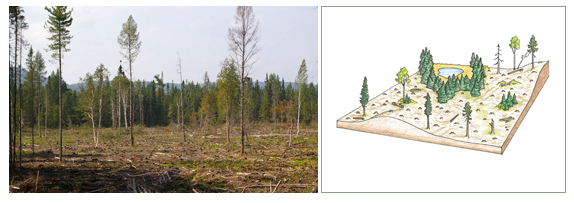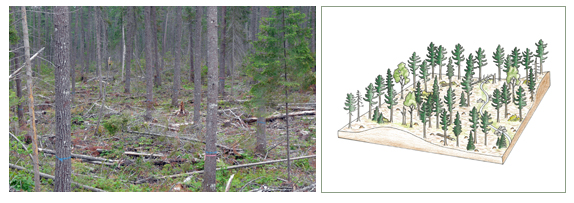Forest renewal
How Ontario’s forest are renewed, tended and protected after they are harvested.
The law
By law, forest managers must carry out renewal and maintenance activities on harvested areas to provide for the sustainability of Crown forests in Ontario. All areas harvested are required to be regenerated.
Manuals authorized by the Crown Forest Sustainability Act provide direction and guidance to resource managers responsible for managing and operating in Crown forests.
Forest regeneration
The act of growing back the forest by natural or artificial means after harvesting trees.
Natural regeneration
Forests can regenerate naturally from:
- root sprouts (suckers)
- stump sprouts (shoots)
- seeding from the adjacent forest
- continued growth of young trees remaining on the harvested site
Natural regeneration:
- ensures that only trees suited to the site are established
- is low in cost
- may take longer for forests to grow back
- can result in stands that have species other than desired species
- is often relied upon to renew areas affected by natural disturbances (e.g. fire, insect, disease, severe weather)
Artificial regeneration
Forests can also be regenerated artificially by direct seeding or by planting trees.
Artificial regeneration:
- is more expensive than natural regeneration
- may allow a site to grow back more quickly
- allows forest managers to focus on desirable trees species with good genetics to grow a healthy forest
- requires lots of seed for direct seeding and to grow planting stock
Site Preparation
To get harvested areas ready for natural or artificial regeneration, the ground may need to be prepared.
Site preparation can include one or more of:
- raking or pushing logging slash (foliage, branches, decaying logs, etc.) into piles
- tilling the ground
- burning woody debris and undesirable vegetation
- killing undesirable vegetation with herbicides
Silviculture
A silviculture system is harvesting combined with forest renewal and maintenance activities (e.g., tending, protection). These systems are classified according to the method of harvesting.
Ontario uses 3 silviculture systems based on the characteristics of the current forest as well as the desired forest condition:
Clearcut system

- harvest areas emulate the size, structure and characteristics of natural disturbances such as forest fires and windstorms
- individual trees and clumps of trees are not harvested to provide protection for forest values (like wildlife habitat)
- regenerated naturally or artificially by planting or seeding or a combination of both
- produces trees that are mostly the same age, known as even-aged management
- applied to trees species (e.g., jack pine, poplar, white birch) that can regenerate in full sunlight after a natural disturbance
- within 5-10 years a new, highly productive forest will be growing
- primarily used in the Boreal Forest Region
Report on clearcut silviculture in Ontario
Forest Management Guide for Natural Disturbance Pattern Emulation
Shelterwood system

- harvest areas emulate the results of small periodic ground fires, wind storms and insect infestations
- mature trees are harvest in a series of 2 or more cuts to encourage natural regeneration and growth under, or next to, the residual trees by cutting trees uniformly, in groups or narrow strips
- produces trees that are mostly the same age, known as even-aged management
- mainly used in treed areas of white and red pine and hardwoods that tolerate partial shade (e.g., oak, yellow birch)
- can be used to rehabilitate degraded maple, beech and yellow birch in central Ontario
- used in both the Boreal and Great Lakes – St. Lawrence Forest Regions
Selection system

- harvest areas emulate the results of individual trees or groups of trees dying by insect or disease, wind storms
- mature, unhealthy or undesirable trees are individually harvested or in small groups, every 10 to 40 years
- produces trees of different ages, known as uneven-aged management
- applied to trees species (e.g., maple, ash, beech) that tolerate shade
- primarily used in the Great Lakes – St. Lawrence Region
Tending treatments
Tending is used to control competing vegetation in a young developing forest.
Tending activities include:
- thinning or spacing – manage tree densities to promote healthy growth by removing trees to allow remaining trees to grow rapidly
- weeding or cleaning – remove competing plants by using mechanical cutting (e.g., brush saws) or herbicides to allow the desired trees to grow healthier
Herbicides
- are a tool used to control competing vegetation in a young developing forest
- are registered by the federal government and approved for use in Ontario by the Ministry of Environment
- can be applied from the ground or from the air, under strict controls
- are a fast and very effective way to help seedlings grow into a healthy forest
Forest protection
To protect forest from threats (e.g., insects, diseases, extreme weather, forest fires), Ontario:
- monitors factors that affect forest health to plan forest management and pest management programs, design research projects, invasive species strategies and climate change programs, and support sustainability and biodiversity
- practices fire suppression to protect valuable forest resources and neighbouring communities
Report on forest health conditions
Forest renewal report
Every year, Ontario produces provincial reports that include information on:
- forest renewal
- tending and protection activities
- renewal survey results
- assessment results
- forest summaries and facts